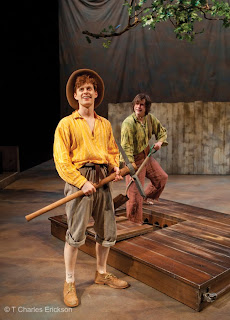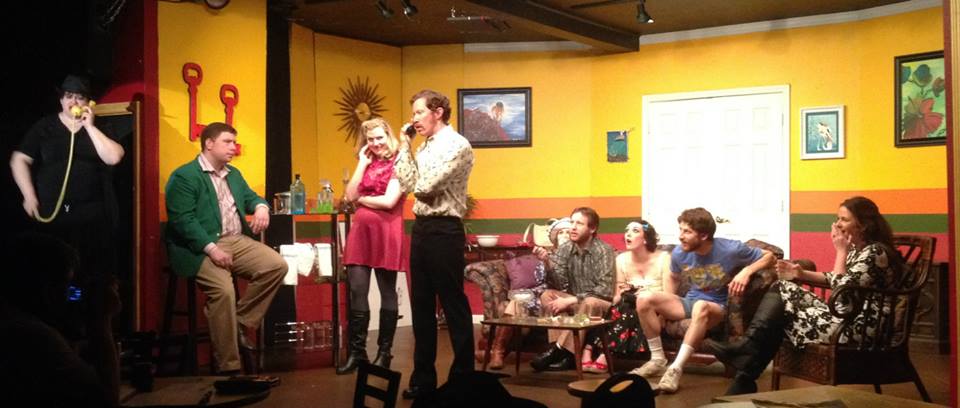Six years ago Laura Eason adjusted the focus of her career to concentrate on life as a playwright. The former actor, musician and artistic director made a name for herself as a member of Chicago’s Lookingglass Theatre Company, an eccentric ensemble founded a quarter century ago by Northwestern University alums. Eason today is one of the American theatre’s most prolific and increasingly produced playwrights who divides her time between original scripts and adaptations of classic literature for the stage. Her latest work, The Adventures of Tom Sawyer, brings the residents of Mark Twain’s Missouri River town to Actors Theatre of Louisville.
SD: I read somewhere that you started training as an actor early on.
LE: I started taking classes at the Piven Theatre Workshop in my hometown of Evanston, Illinois, when I was eleven or twelve. I came out of the story theatre tradition, and my interest in working with dramatic texts actually began there. My imagination really caught fire – theatre got a hold of me then and never let go.
SD: You’ve adapted The Adventures of Tom Sawyer for the stage, but you also write a lot of original plays. Are the processes very different?
LE: Well, when you’re doing an adaptation you’re having a very strong collaboration with the source material – you have a pre-existing work in which to relate. I liken it, in a way, to building a new house with salvaged materials. You’re making something totally new but using pieces – sometimes very important structural, fundamental, essential pieces – from something that already exists. But the ultimate goal of adaptation is to make something that can stand on its own – with its own structural integrity, charm and sensibility – while maintaining a strong and important relationship to the source.
SD: You have adapted a number of classics. Have you ever adapted a work by a living author?
LE: I’ve adapted both living authors and those who aren’t with us anymore. It’s interesting – even with a deceased author as in the case of Mark Twain, he is such an important part of the cultural consciousness that even though he’s not alive, his voice is living in so many people that I’m still having a conversation with his legacy.
SD: You adapted Huckleberry Finn as well. Mark Twain wrote both books, but they are substantially different.
LE: In a way, Tom Sawyer was a relief after Huck Finn. Tom Sawyer is also greatly loved and people have a strong attachment to the material, but it’s not the same kind of devotion. People hold Huck Finn up as one of the greatest – if not the greatest – novels in American literature. You have to make choices in adaptation, which means not including certain things or changing certain things to make it work in a dramatic context. How sensitive people are to the strong hand you have to take in creating a successful theatre piece can be more or less difficult, depending on how beloved the novel is – and its level of sanctification.
SD: It sounds as though it is a very different process than when you create an original play.
LE: Yes, with an original play, I can just write whatever I want and people can like it or not like it. But the opinion they’re having isn’t related to the transition from novel to play – it’s about the merits of the play itself. The amazing thing about adaptation is you get to have this very deep, strong relationship with the source material. That’s really a gift when you get to work with writers like Mark Twain, Charles Dickens and Jules Verne – all of whom I’ve adapted. I’ve had a great opportunity to learn and grow as a writer from having the relationship with these texts.
SD: Has that affected your writing?
LE: I feel I’m a better writer because of the time I’ve spent with them. I’m a much funnier writer, and I have a better understanding of comedy because of Twain. From Dickens, I have developed a better understanding of character. It’s a huge pleasure to collaborate with these masters.
SD: How did you come to write your adaptation of The Adventures of Tom Sawyer?
LE: My friend Jeremy Cohen from The Hartford Stage in Connecticut called me up to say Hartford was interested in doing a new adaptation of The Adventures of Tom Sawyer to coincide with the 100th anniversary of Twain’s death and the 175th anniversary of his birth. I’ve known Jeremy since he was the artistic director of Naked Eye Theatre in Chicago years ago, and he knew my work from the Lookingglass Theatre Company. They reached out to a couple of playwrights and, luckily, they picked me to do it.
SD: How long did you work on it?
LE: The first phone call and the world premiere opening night in Hartford were less than a year apart, so it was a very fast turnaround for the project. But Jeremy really understood how to direct adaptation.
SD: What do you mean by that?
LE: How you move through time and space in adaptation is often quite different. The play is very physical, very visual, and I needed a director who was going to understand how to tell the story not only through words, but also through picture, image and movement. It’s been a wonderful experience. This trip to Actors Theatre of Louisville is the start of a four-city tour. My adaptation has also been produced at the People’s Light Theatre in Philadelphia and it will be produced at the Denver Center Theatre this year as well.
SD: Have you made any changes since the premiere?
LE: I’ve made a couple of tiny text changes, but it’s the same production. We may have a different costume designer, but it’s essentially the same team. Our cast, however, is quite different, with the exception of the actor who plays Tom Sawyer.
SD: Actors Theatre patrons remember Lookingglass Theatre brought Lookingglass Alice to play here two seasons ago. You spent time as artistic director of the company.
LE: I was artistic director of Lookingglass for a total of six years, over two terms. The first was in the mid ’90s – I was 24 years old, so I hadn’t had that kind of management experience before. I learned a lot on the job, which was both interesting and challenging. By the time the second term came around in 2000, when we opened our new facility on Michigan Avenue, I felt really ready to help lead the company through our capital campaign and the opening of the theatre.
SD: You take leadership in turns?
LE: We have an artistic ensemble, so it’s different from other theatres. We are a collective of ensemble members, many of whom have been with the company since its founding in 1988. Although you’re the leader of the company, there is an amazing support system in these artists who are deeply invested, and you are one of them. There is no division between artistic leadership and the ensemble; you’re all ultimately part of the collective. It’s a wonderfully supportive environment, and it was a huge gift to my career and my life.
SD: The balance between art and fiduciary realities have always been in tension, but never more so than now. What kind of insights did that experience give you?
LE: I could talk about that for hours, but most applicable to my work now as a playwright is my awareness of the realities of the theatre – i.e., as people are reading plays, they are thinking about whether or not they can be produced. I’m more realistic about what I put on the page, knowing that if things are really extravagant or challenging, they need to be framed in such a way that the theatre feels they have options. I don’t rest the entire play on things that could be difficult or expensive. I also know from my time at Lookingglass that you can create a lot of magic without a lot of money. I also know you need a certain amount of money to allow people to live their lives as artists and show up. There is a sweet spot we need to hit in the theatre, but money isn’t always the answer.
SD: Do you feel that as a limiting factor? Do you self-edit?
LE: I don’t think it stops my imagination, but I know how to present my work in a way that isn’t scary to those watching the bottom line. It can manifest in a very positive way. In terms of cast size, for instance – when I’m writing a play for Lookingglass, I might conceive a show with a cast of twelve. But I wouldn’t do that for a show I was sending out to the general theatrical community because that is, unfortunately, prohibitive at this point. It’s a constant conversation in the community and within individual theatres: “What is enough to keep going? How much do we need? What is the relationship between money and creativity?” Those are big and important questions. But the one thing I do know is that the theatre will endure. I’ve seen it in my own little company that is about to turn 25 years old. We do almost all original work in a very physical and visual style that often lands outside audience expectations. I feel that if a bunch of kids out of Northwestern University who believed in their vision can win a regional Tony Award and become a Chicago institution in this very difficult climate, theatre will continue to be relevant and important.
SD: The word “relevant” has been tossed around in relation to theatre for more than three decades now. What does relevancy mean to you?
LE: People think theatre has become irrelevant because the world has become so connected to the medium of the inter-
net. So much of our life is now virtual that some people believe live events are being less valued. But I really think people are going to continue to seek out the experi-
ences you can only have with other human beings in the same room. I’m very optimistic about the future of the theatre. It will change and we all have to adapt as the world changes. But there is something very moving about the fact that when we’re in rehearsal for a play, we’re doing pretty much the same thing actors did a couple thousand years ago: We are bodies in a room telling a story. We are still connecting to this deeper aspect of humanity.
SD: Tell me about your process when you’re writing without the boundaries of adaptation.
LE: Just as in an adaptation, I need to decide what the play is about. It may come to me through a character, but early in the process I know the questions I’m asking and what questions I want to be in the air. I came out of the performance art world, so I understand what it’s like to be at a show and say, “I’ve no idea what this is about,” and yet I’m having a wonderful time! But I want people to be able to walk out and say, “This show was asking these questions.” That feels important to me. I want people to know why they should care when they come to see my plays.
Laura Eason’s adaptation of Mark Twain’s The Adventures of Tom Sawyer runs October 4-29 at Actors Theatre’s Pamela Brown Auditorium. For tickets and more information, call 502.584.1205 or to go to ActorsTheatre.org.
Tim McKiernan and Casey Predovic as Tom and Huck. Photo by T. Charles Erickson.






